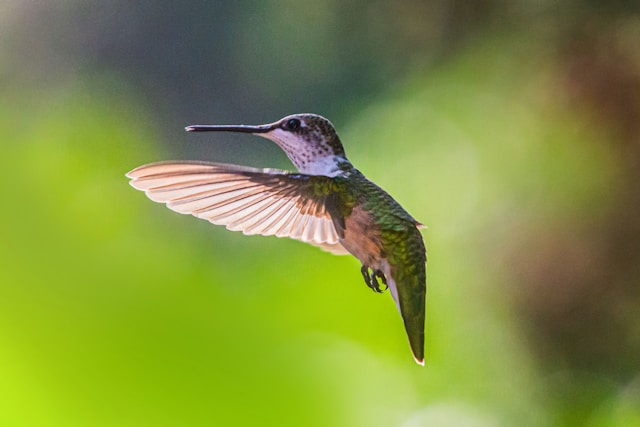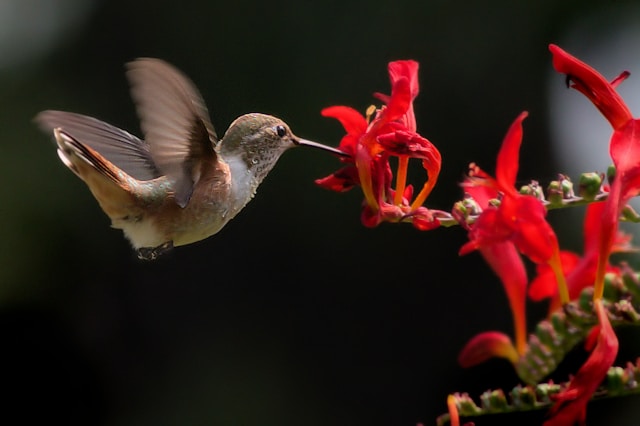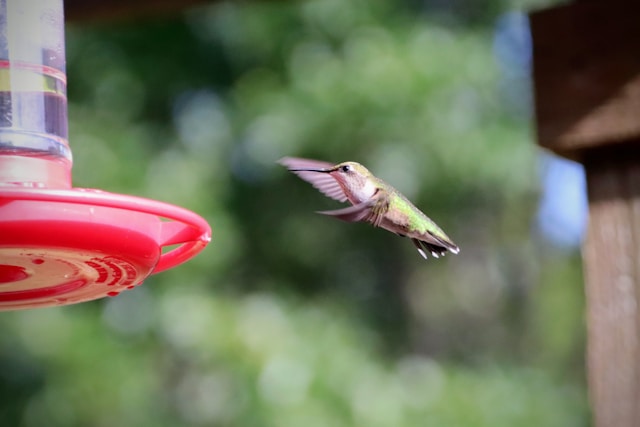Hummingbirds, with their vibrant colors and rapid wingbeats, are among the most enchanting birds to observe.
While they’re most commonly associated with tropical regions, several species can be spotted in the state of New York, particularly during the warmer months. These tiny birds are not only a delight to watch but are also important pollinators.
In this guide, we’ll explore five species of hummingbirds you can find in New York, providing insight into their characteristics, migration patterns, and where to spot them.
1. Ruby-throated Hummingbird (Archilochus colubris)
The Ruby-throated Hummingbird is by far the most common hummingbird species in New York. If you have a hummingbird feeder in your garden, this is likely the bird you’ll see.
- Males are known for their striking metallic green backs and bright red throats (known as a gorget), which glisten in sunlight.
- Females lack the red throat and have white underbellies with greenish backs.
Migration Patterns:
Ruby-throated Hummingbirds migrate to New York in the spring and summer from Central America. They begin their journey in late April and stay until early September before heading south again for the winter.
Where to Spot Them:
You can often spot Ruby-throated Hummingbirds in gardens, woodlands, and parks throughout the state. Planting nectar-rich flowers or hanging hummingbird feeders filled with sugar water can attract these birds to your yard.
2. Rufous Hummingbird (Selasphorus rufus)

The Rufous Hummingbird is less common in New York but can occasionally be spotted, especially during migration.
- Males are coppery orange with iridescent red throats.
- Females are greenish on top with rufous (rusty) sides and white bellies.
Migration Patterns:
Rufous Hummingbirds are typically found in the western United States but are known for their long migratory journeys, occasionally bringing them to New York during late summer or fall.
Where to Spot Them:
These hummingbirds are rare visitors to New York. Still, you might glimpse them during their migration period, particularly in gardens with tubular flowers or at well-stocked feeders.
3. Black-chinned Hummingbird (Archilochus alexandri)
Although uncommon in New York, the Black-chinned Hummingbird has been reported in the state, especially during migration or due to changing weather patterns.
- Males have a black chin and a subtle purple band across their throats.
- Females resemble Ruby-throated Hummingbirds, with green backs and pale underbellies, making them harder to distinguish.
Migration Patterns:
Black-chinned Hummingbirds primarily reside in the western United States but have been spotted as far east as New York during migration. They typically migrate in late spring and early fall.
Where to Spot Them:
Keep an eye out for Black-chinned Hummingbirds near flower beds and feeders, especially during migration periods. They are rare, but a lucky few may catch sight of one.
4. Calliope Hummingbird (Selasphorus calliope)
The Calliope Hummingbird is the smallest bird species in the United States and a rare visitor to New York.
- Males have distinctive magenta streaks on their throats.
- Females are paler, with greenish backs and white underparts.
Migration Patterns:
Calliope Hummingbirds typically migrate from the northwestern U.S. and Canada to Mexico for the winter, but some have been spotted in New York during migration.
Where to Spot Them:
Due to their rarity in New York, spotting a Calliope Hummingbird is a special treat. They may appear in flower gardens or near feeders in the late summer and early fall.
5. Broad-billed Hummingbird (Cynanthus latirostris)
The Broad-billed Hummingbird is a rare sight in New York, but there have been a few documented sightings.
- Males have striking blue throats and greenish-blue bodies, with bright red bills.
- Females are duller, with grayish-green upperparts and paler bellies.
Migration Patterns:
Broad-billed Hummingbirds are typically found in the southwestern United States and Mexico. However, these stunning birds occasionally wander far outside their usual range, sometimes making it to New York.
Where to Spot Them:
You might spot a Broad-billed Hummingbird in a well-maintained garden, park, or even a nature reserve if you’re lucky. Look for them during the late summer months when wandering individuals occasionally appear unexpectedly.

Tips for Attracting Hummingbirds to Your Garden
If you’re hoping to attract hummingbirds to your yard, here are a few tips to encourage their visits:
- Plant Native, Nectar-rich Flowers: Hummingbirds are particularly attracted to red, tubular flowers like bee balm, trumpet vine, and columbine.
- Install Feeders: Fill hummingbird feeders with a mixture of four parts water to one part sugar (no red dye). Clean feeders regularly to prevent mold and harmful bacteria.
- Provide Fresh Water: A shallow birdbath or misting fountain can attract hummingbirds looking for a drink or a quick bath.
- Create Shelter: Hummingbirds appreciate trees or shrubs for nesting and shelter, so consider planting a variety of greenery to give them a place to rest.
Hummingbird season in New York typically begins in late April and lasts until early September, when most species migrate to warmer climates.
The arrival of hummingbirds in the spring coincides with the blooming of nectar-rich flowers, providing these tiny birds with the fuel they need after their long migration from Central and South America.
During the summer months, New York becomes a temporary home for these energetic birds, making it the perfect time for bird enthusiasts to set up feeders and plant hummingbird-friendly gardens.
Spring Migration: April to May
The first hummingbirds to arrive in New York are usually Ruby-throated Hummingbirds, the most common species in the state.
Their arrival begins in late April, as they make their way north after spending the winter in Central America. During this time, male hummingbirds arrive slightly earlier than females to establish their territories, often choosing spots with abundant food sources.
As soon as temperatures rise and flowers begin to bloom, hummingbirds start feeding and mating. Early spring is an excellent time to put out hummingbird feeders filled with fresh sugar water, as natural food sources may still be limited.
Summer: Prime Time for Hummingbird Activity
Throughout the summer months, hummingbirds are in full swing, buzzing around gardens, parks, and woodlands across New York. You’ll often see them hovering near flowers or feeders from May through August, constantly seeking nectar to fuel their rapid wingbeats.
During this period, female hummingbirds are busy nesting and raising their young. If you’re lucky, you may spot a female building a tiny nest made of plant fibers and spider silk, often tucked away in trees or shrubs.
Mid-summer is the best time for hummingbird watching, as the birds are more active and visible, especially early in the morning and late in the afternoon when they feed more frequently.
Fall Migration: August to September
As summer ends, hummingbirds prepare to migrate back to Central America. By late August, you may notice increased hummingbird activity as they begin to fatten up for their journey south.
This is the perfect time to keep your feeders full, as migrating hummingbirds will stop to refuel.
Most hummingbirds leave New York by mid-September, although stragglers may still be spotted through early October. During the fall migration, it’s important to continue offering food and water to support these birds as they prepare for their challenging trek.
Best Time to See Hummingbirds in New York
The best time to observe hummingbirds in New York is from late May to early August, when their population is at its peak, and the birds are actively foraging and nesting. During this time, gardens filled with nectar-rich flowers and well-maintained feeders will attract hummingbirds, allowing you to watch their fascinating behavior up close.
By understanding the hummingbird season in New York and preparing your garden accordingly, you can ensure these captivating birds visit your backyard year after year.
Conclusion
New York may not be the first place that comes to mind when thinking of hummingbirds, but these tiny, colorful birds appear in the state. Whether you spot the common Ruby-throated Hummingbird or are lucky enough to see a rare visitor like the Calliope or Rufous Hummingbird, these beautiful creatures are always a delight.
Creating a hummingbird-friendly environment in your garden can increase your chances of seeing these fascinating birds up close. Keep your feeders full, plant nectar-rich flowers, and enjoy the spectacle of hummingbirds as they zip through your backyard, bringing a touch of tropical magic to New York’s landscapes.
